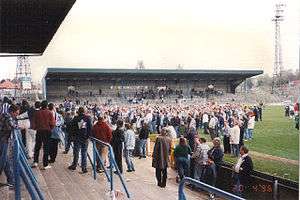Goldstone Ground
| The Goldstone | |
|
Goldstone Ground in 1976 | |
| Location | Hove 4, England |
|---|---|
| Construction | |
| Opened | 1901 |
| Closed | 1997 |
| Demolished | 1997 |
| Tenants | |
|
1901–1904 Hove F.C. 1902–1997 Brighton & Hove Albion F.C. 1995 Wimbledon F.C. (European matches) | |
The Goldstone Ground (or The Goldstone) was a football stadium and home ground of Brighton & Hove Albion F.C. between 1902 and 1997. The club currently plays at American Express Community Stadium, a stadium on the outskirts of the city, following the move from their temporary stadium in the Brighton suburb of Withdean.
After the sale of the ground to private developers, the area was changed to a row of warehouse style retail shops, along with a "drive-through" Burger King outlet.
History
The Goldstone Ground stood on Old Shoreham Road, Hove 4 opposite Hove Park in a partly residential area. The area was previously part of Goldstone Farm and was first used for a football match by Hove F.C. on 7 September 1901.[1] Albion played there for the first time on 22 February 1902, and it became the club's permanent home the next season.[2]
The main West Stand was largely built in 1958 and consisted of seating and terraces. The South Stand was originally built in 1949 and served family spectators. The North Stand was built in 1984 and consisted solely of terraces. The East Stand was formed of uncovered terraces. Floodlights were first installed in 1961.[3] The ground also hosted football games for the 1948 Olympic Games, one of only two grounds outside London (the other being Fratton Park).

On 23 September 1992, David Beckham made his professional début at this stadium, coming on as a substitute for Manchester United in a League Cup Second Round tie.
Closure and sale
The last game at The Goldstone was held on 26 April 1997, in which Brighton beat Doncaster Rovers 1-0. The result lifted Brighton off the bottom of Division Three and meant that a draw or win in their visit to Hereford United the following weekend would prevent relegation to the Conference and preserve their Football League status. Brighton went on to draw the game 1-1 and secure survival - thus avoiding becoming the first former members of the top flight or the first major cup finalists to be relegated to the Conference.
Between 1902 and 1997 the ground had admitted 22.9 million supporters to 2,174 games.[4] The largest attendance at the Goldstone was 36,747 when the Albion played Fulham on 27 December 1958.[5]
The ground was sold by the board, who were trying to clear the club's mounting debts in an attempt to avoid bankruptcy, although no alternative football ground had been lined up, and without consulting the fans.[6] The then chairman, Bill Archer, aimed to profit from the sale of the lucrative development land on which the Goldstone stood. A ground share with Portsmouth never materialised and the club eventually arranged a ground-share with Gillingham at their Priestfield Stadium over 70 miles from Brighton.

The sale of the club's stadium provoked two pitch invasions by angry fans in protest against it. A pitch invasion late in the 1995-96 season, when the Seagulls were relegated to Division Three, resulted in a suspended sentence of three points deducted and a game played behind closed doors for the club. A similar protest on 1 October 1996 in a league game against Lincoln City meant that a Football League hearing on 9 December that year saw them deducted two league points.[7] The club later appealed against the points deduction but their appeal was rejected, although ultimately they still managed to avoid relegation from the Football League by a narrow margin that year.[8]
The Goldstone Ground was sold to property developers and it has since been redeveloped as a retail park.
References
- ↑ The name "Goldstone" is derived from a rock in Hove Park: see "The Goldstone". Public Sculptures of Sussex. Retrieved 20 July 2010. External link in
|work=(help) - ↑ Carder, Timothy. The Encyclopedia of Brighton. (1990) s.20 ISBN 0-86147-315-9
- ↑ Carder (1990), s.20
- ↑ "Goldstone Ground - From the start to the finish". My Brighton and Hove. Retrieved 20 July 2010.
- ↑ Carder (1990). s.20
- ↑ "Still Missing the Goldstone Ground". Shoreham Herald. Retrieved 20 July 2010.
- ↑ "Brighton have two points deducted". The Independent. London. 10 December 1996. Retrieved 20 July 2010.
- ↑ "Football: Gritt backs legal campaign". The Independent. London. 10 April 1997. Retrieved 20 July 2010.
Coordinates: 50°50′17.09″N 0°10′26.72″W / 50.8380806°N 0.1740889°W
